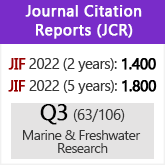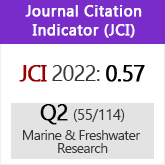Inter- and intra-annual trends and status indicators of nektobenthic elasmobranchs off the Balearic Islands (northwestern Mediterranean)
DOI:
https://doi.org/10.3989/scimar.03432.22AKeywords:
elasmobranchs, assessment, Traffic Light method, indicators, fishing effort, Balearic IslandsAbstract
We assessed the elasmobranch communities exploited by the bottom trawl fishery off the Balearic Islands (northwestern Mediterranean) by analysing two time series containing information with different levels of detail: 1) a long-term series containing the abundance indices of the whole elasmobranch community landed from 1965 to 2009; and 2) a shorter time series from 2000 to 2009 from two different data sources (daily sales records: 2000-2009; bottom trawl surveys: 2001-2009), with information that allowed the shelf and slope to be analysed separately and different community parameters and abundance indices to be studied. Temporal trends of all these variables were used as ecological status indicators and tested with generalized additive models and analysis of variance. They were finally summarised using the Traffic Light methodology. The long-term series showed two marked trends, an inter-annual decreasing trend that would be a consequence of the large increase in fishing effort, and an intra-annual trend with a clear peak in May in accordance with the seasonal biological cycle of these species. However, data from the last ten years revealed differences between the shelf and slope, as some parameters increased significantly over time on the shelf but did not follow any trend on the slope. The Traffic Light methodology captured these differences well, demonstrating its usefulness for interpreting ecological transitions at a glance.
Downloads
References
Aldebert Y. 1997. Demersal resources of the Gulf of Lions (Mediterranean). Impact on fish diversity. Vie Milieu 47: 275-284.
Baeta F., Batista M., Maia A., Costa M.J., Cabral H. 2010. Elasmobranch bycatch in a trammel net fishery in the Portuguese west coast. Fish. Res. 102(1-2): 123-129. http://dx.doi.org/10.1016/j.fishres.2009.10.016
Bertrand J.A., Aldebert Y., Souplet A. 1998. Temporal variability of demersal species in the Gulf of Lions from trawl surveys (1983-1997). IFREMER Actes des Colloques 26: 153-164.
Bertrand J.A., Gil de Sola L., Papaconstantinou C., Relini G., Souplet A. 2000. Contribution on the distribution of elasmobranchs in the Mediterranean (from the MEDITS surveys). Biol. Mar. Medit. 7: 1-15.
Bertrand J.A., Gil de Sola L., Papaconstantinou C., Relini G., Souplet A. 2002. The general specifications of the MEDITS surveys. Sci. Mar. 66(Suppl. 2): 9-17.
Browman H.I., Stergiou K.I. 2004. Perspectives on ecosystem-based approaches to the management of marine resources. Mar. Ecol. Prog. Ser. 274: 269-270. http://dx.doi.org/10.3354/meps274269
Caddy J.F. 1998. A short review of precautionary reference points and some proposals for their use in data-poor situations. FAO Fisheries Technical Paper. No. 379, Rome, 30 pp.
Caddy J.F. 1999. Deciding on precautionary management measures for a stock based on a suite of Limit Reference Points (LRPs) as abasis for a multi-LRP harvest law. NAFO Sci. Council Stud. 32: 55-68.
Caddy J.F. 2002. Limit reference points, traffic lights, and holistic approaches to fisheries management with minimal stock assessment input. Fish. Res. 56(2): 133-137. http://dx.doi.org/10.1016/S0165-7836(01)00343-5
Caddy J.F., Wade E., Surette T., Hebert M., Moriyasu M. 2005. Using an empirical traffic light procedure for monitoring and forecasting in the Gulf of St. Lawrence fishery for the snow crab, Chionoecetes opilio. Fish. Res. 76(1): 123-145. http://dx.doi.org/10.1016/j.fishres.2005.06.003
Capape C., Tomasini J.A., Quignard J.P. 2000. The Pleurotremate Elasmobranchs from the Languedoc coast (Southern France): biological and demographic observations. Vie Milieu 50(2): 123-133.
Carbonell A., Alemany F., Merella P., Quetglas A., Roman E. 2003. The by-catch of sharks in the western Mediterranean (Balearic Islands) trawl fishery. Fish. Res. 61(1-3): 7-18. http://dx.doi.org/10.1016/S0165-7836(02)00242-4
Casey J.M., Myers R.A. 1998. Near extinction of a large, widely distributed fish. Science 281(5377): 690-692. http://dx.doi.org/10.1126/science.281.5377.690 PMid:9685260
Cavanagh R.D., Gibson C. 2007. Overview of the conservation status of cartilaginous fishes (Condrichthyans) in the Mediterranean Sea. IUCN, Gland, Switzerland and Málaga, Spain, 42 pp. http://dx.doi.org/10.2305/IUCN.CH.2007.MRA.3.en
Ceriola L., Accadia P., Mannini P., Massa F., Milone N., Ungaro N. 2008. A bio-economic indicators suite for the appraisal of the demersal trawl fishery in the Southern Adriatic Sea (Central Mediterranean). Fish. Res. 92(2-3): 255-267. http://dx.doi.org/10.1016/j.fishres.2008.01.017
Ceriola L., Ungaro N., Toteda F. 2007. A “Traffic” Light approach for the assessment of the Broadtail shortfin squid Illex coindetii Verany, 1839 in the Southern Adriatic Sea (Central Mediterranean). Rev. Fish Biol. Fish. 17(2-3): 145-157. http://dx.doi.org/10.1007/s11160-006-9019-5
Chen Q.X., Chan K.S., Lekve K., Torstensen E., Gjosaeter J., Ottersen
G., Stenseth N.C. 2005. Population dynamics of cod Gadus morhua in the North Sea region: biological density-dependent and climatic density-independent effects. Mar. Ecol. Prog. Ser. 302: 219-232.
Ciannelli L., Chan K.S., Bailey K.M., Stenseth N.C. 2004. Nonadditive effects of the environment on the survival of a large marine fish population. Ecology 85(12): 3418-3427. http://dx.doi.org/10.1890/03-0755
Coelho R., Erzini K. 2008. Effects of fishing methods on deep water shark species caught as by-catch off southern Portugal. Hydrobiologia 606: 187-193. http://dx.doi.org/10.1007/s10750-008-9335-y
Damalas D., Katsanevakis S., Maravelias C.D., Karageorgis A.P., Anagnostou C., Tsitsika E., Papaconstantinou C. 2009. Habitat preferences and spatiotemporal distribution of four benthic skates in the Eastern Mediterranean Sea. 9th Symposium on Oceanography and Fisheries - Proceedings, Volume II: 771-776.
DFO. 2005. Northern Shrimp on the Eastern Scotial Shelf (SFA 13-15). DFO Can. Sci. Advis. Sec. Sci. Advis. Rep. 2005/060.
Dulvy N.K., Baum J.K., Clarke S., Compagno L.J.V., Cortes E., Domingo A., Fordham S., Fowler S., Francis M.P., Gibson C., Martinez J., Musick J.A., Soldo A., Stevens J.D., Valenti S. 2008. You can swim but you can’t hide: the global status and conservation of oceanic pelagic sharks and rays. Aquat. Conserv. 18(5): 459-482. http://dx.doi.org/10.1002/aqc.975
Dulvy N.K., Metcalfe J.D., Glanville J., Pawson M.G., Reynolds J.D. 2000. Fishery stability, local extinctions, and shifts in community structure in skates. Conserv. Biol. 14(1): 283-293. http://dx.doi.org/10.1046/j.1523-1739.2000.98540.x
Ellis J., Dulvy N.K., Jennings S., Parker-Humphreys M., Rogers S.I. 2005. Assessing the status of demersal elasmobranchs in UK waters: a review. J. Mar. Biol. Ass. U.K. 85(5): 1025-1047. http://dx.doi.org/10.1017/S0025315405012099
Garofalo G., Gristina M., Fiorentino F., Fulgosi F.C., Norrito G., Sinacori G. 2003. Distributional pattern of rays (Pisces, Rajidae) in the Strait of Sicily in relation to fishing pressure. Hydrobiologia 503(1-3): 245-250. http://dx.doi.org/10.1023/B:HYDR.0000008487.25578.d4
Gouraguine A., Hidalgo M., Moranta J., Bailey D.M., Ordines F., Guijarro B., Valls M., Barberá C., Quetglas A., De Mesa A. 2011. Spatial segregation between deep water elasmobranch species related to biological and environmental factors. Sci. Mar., 75(4): 653-664.
Guijarro B., Massutí E. 2006. Selectivity of diamond- and square-mesh codends in the deepwater crustacean trawl fishery off the Balearic Islands (western Mediterranean). ICES J. Mar. Sci. 63(1): 52-67. http://dx.doi.org/10.1016/j.icesjms.2005.08.011
Guijarro B., Massutí E., Moranta J., Díaz P. 2008. Population dynamics of the red shrimp Aristeus antennatus in the Balearic Islands (western Mediterranean): Short spatio-temporal differences and influence of environmental factors. J. Mar. Syst. 71: 385-402. http://dx.doi.org/10.1016/j.jmarsys.2007.04.003
Guijarro B., Tserpes G., Moranta J., Massutí E. 2011. Assessment of the deep water trawl fishery off the Balearic Islands (western Mediterranean): from single to multi-species approach. Hydrobiologia, 670: 67-85. http://dx.doi.org/10.1007/s10750-011-0670-z
Halliday R.G., Fanning L.P., Mohn R.K. 2001. Use of the Traffic Light Method in Fishery Management Planning. 2001/108 ISSN 1480-4883: 1-41.
Hastie T.J., Tibshirani R.J. 1990. Generalized Additive Models. Chapman and Hall, New York, 335 pp.
Hidalgo M., Massutí E., Guijarro B., Moranta J., Ciannelli L., Lloret J., Oliver P., Stenseth N.C. 2009. Population effects and changes in life history traits in relation to phase transitions induced by long-term fishery harvesting: European hake (Merluccius merluccius) off the Balearic Islands. Can. J. Fish. Aquat. Sci. 66: 1355-1370 http://dx.doi.org/10.1139/F09-081
Jennings S. 2005. Indicators to support an ecosystem approach to fisheries. Fish and Fisheries 6(3): 212-232. http://dx.doi.org/10.1111/j.1467-2979.2005.00189.x
Koeller P., Savard L., Parsons D.G., Fu C. 2000. A precautionary approach to assessment and management of shrimp stocks in the Northwest Atlantic. J. Northwest Atl. Fish. Soc. 27: 235-246. http://dx.doi.org/10.2960/J.v27.a20
Massutí E., Monserrat S., Oliver P., Moranta J., López-Jurado J.L., Marcos M., Hidalgo M., Guijarro B., Carbonell A., Pereda P. 2008. The influence of oceanographic scenarios on the population dynamics of demersal resources in the western Mediterranean: Hypothesis for hake and red shrimp off Balearic Islands. J. Mar. Syst. 71: 421-438. http://dx.doi.org/10.1016/j.jmarsys.2007.01.009
Massutí E., Moranta J. 2003. Demersal assemblages and depth distribution of elasmobranchs from the continental shelf and slope off the Balearic Islands (western Mediterranean). ICES J. Mar. Sci. 60(4): 753-766. http://dx.doi.org/10.1016/S1054-3139(03)00089-4
Moranta J., Quetglas A., Massutí E., Guijarro B., Hidalgo M., Díaz P. 2008. Spatio-temporal variations in deep-sea demersal communities off the Balearic Islands (western Mediterranean). J. Mar. Syst. 71(3-4): 346-366. http://dx.doi.org/10.1016/j.jmarsys.2007.02.029
Morey G., Moranta J., Riera F., Grau A.M., Morales-Nin B. 2006. Elasmobranchs in trammel net fishery associated to marine reserves in the Balearic Islands (NW Mediterranean). Cybium 30(4): 125-132.
Morey G., Navarro O. 2010. Monitoring of elasmobranchs landings in Mallorca (Balearic Islands, NW Mediterranean). Identification at species level and understanding of the official statistics. In: Book of abstracts of the 14th European Elasmobranch Association Conference. 10th-12th November 2010. Galway, Ireland.
Mouffok S., Massutí E., Boutiba Z., Guijarro B., Ordines F., Fliti K. 2008. Ecology and Fishery of the Deep-Water Shrimp, Aristeus Antennatus (Risso, 1816) Off Algeria (South-Western Mediterranean). Crustaceana 81(10): 1177-1199. http://dx.doi.org/10.1163/156854008X374513
Ordines F., Massutí E. 2009. Relationships between macro-epibenthic communities and fish on the shelf grounds of the western Mediterranean. Aquat. Conserv. 19(4): 370-383. http://dx.doi.org/10.1002/aqc.969
Ordines F., Massutí E., Guijarro B., Mas R. 2006. Diamond vs square mesh codend in a multi-species trawl fishery of the western Mediterranean: effects on catch composition, yield, size selectivity and discards. Aquat. Living Resour. 19(4): 329-338. http://dx.doi.org/10.1051/alr:2007003
Ordines F., Massutí E., Moranta J., Quetglas A., Guijarro B., Fliti K. 2011. Balearic Islands vs Algeria: two nearby western Mediterranean elasmobranchs populations with different oceanographic scenarios and fishing histories. Sci. Mar. 75(4): 707-717. http://dx.doi.org/10.3989/scimar.2011.75n4707
Palmer M., Quetglas A., Guijarro B., Moranta J., Ordines F., Massutí E. 2009. Performance of artificial neural networks and discriminant analysis in predicting fishing tactics from multispecific fisheries. Can. J. Earth Sci. 66(2): 224-237.
Relini G., Biagi F., Serena F., Belluscio A., Spedicato M.T., Rinelli P., Follesa M.C., Piccinetti C., Ungaro N., Sion L., Levi D. 2000. I Selaci pescati con lo strascico nei mari italiani. Biol. Mar. Medit. 7: 347-384.
Rochet M.J., Trenkel V.M. 2003. Which community indicators can measure the impact of fishing? A review and proposals. Can. J. Earth Sci. 60(1): 86-99.
Rogers S.I., Maxwell D., Rijnsdorp A.D., Damm U., Vanhee W. 1999. Fishing effects in northeast Atlantic shelf seas: patterns in fishing effort, diversity and community structure. IV. Can comparisons of species diversity be used to assess human impacts on demersal fish faunas? Fish. Res. 40(2): 135-152. http://dx.doi.org/10.1016/S0165-7836(98)00209-4
Serena F., Papaconstantinou C., Relini G., Gil de Sola L., Bertrand J.A. 2009. Distribution and abundance of spiny dogfish in the Mediterranean Sea based on the Mediterranean International Trawl Survey Program. In: Gallucci V.F., Mcfarlane G.A., Bargmann G.G. (eds.), Biology and management of Dogfish Sharks. American Fisheries Society, pp. 139-149.
Smith S.E., Au D.W., Show C. 1998. Intrinsic rebound potentials of 26 species of Pacific sharks. Mar. Freshw. Res. 49(7): 663-678. http://dx.doi.org/10.1071/MF97135
Stevens J.D., Bonfil R., Dulvy N.K., Walker P.A. 2000. The effects of fishing on sharks, rays, and chimaeras (chondrichthyans), and the implications for marine ecosystems. ICES J. Mar. Sci. 57(3): 476-494. http://dx.doi.org/10.1006/jmsc.2000.0724
Walker T.I. 1998. Can shark resources be harvested sustainably? A question revisited with a review, of shark fisheries. Mar. Freshw. Res. 49(7): 553-572. http://dx.doi.org/10.1071/MF98017
Wood S.N. 2004. Stable and efficient multiple smoothing parameter estimation for generalized additive models. J. Am. Stat. Ass. 99: 673-686. http://dx.doi.org/10.1198/016214504000000980
Downloads
Published
How to Cite
Issue
Section
License
Copyright (c) 2012 Consejo Superior de Investigaciones Científicas (CSIC)

This work is licensed under a Creative Commons Attribution 4.0 International License.
© CSIC. Manuscripts published in both the printed and online versions of this Journal are the property of Consejo Superior de Investigaciones Científicas, and quoting this source is a requirement for any partial or full reproduction.All contents of this electronic edition, except where otherwise noted, are distributed under a “Creative Commons Attribution 4.0 International” (CC BY 4.0) License. You may read here the basic information and the legal text of the license. The indication of the CC BY 4.0 License must be expressly stated in this way when necessary.
Self-archiving in repositories, personal webpages or similar, of any version other than the published by the Editor, is not allowed.
















